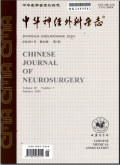未定带尾部与丘脑底核脑深部电刺激治疗震颤型帕金森病的疗效分析
Observation on the efficacy of deep brain stimulation of the caudal zona incerta and subthalamic nucleus in the treatment of tremor-dominant Parkinson′s disease
摘要目的:对比分析未定带尾部(cZI)与丘脑底核(STN)脑深部电刺激(DBS)治疗震颤型帕金森病(PD)患者的疗效、刺激参数及不良反应等方面的差异。方法:纳入26例2018年9月至2021年11月武汉大学中南医院神经外科采用DBS治疗的震颤型PD患者的资料进行回顾性分析。其中以cZI为刺激靶点者(cZI-DBS组)10例(19侧),以STN为刺激靶点者(STN-DBS)16例(30侧)。比较两组术后开机与未开机时统一PD评定量表第三部分(UPDRS-Ⅲ)评分及其子项目评分(包括震颤、僵硬、步态障碍及运动迟缓评分)的改善率、开机后左旋多巴等效日剂量(LEDD)较术前的减少率、刺激参数及与刺激相关的不良反应等的差异。结果:术后1、3、9、12个月,与未开机时比较,开机后两组患者的UPDRS-Ⅲ、震颤、僵硬、步态障碍、运动迟缓评分的平均或中位改善率均≥50%。两组比较,术后各时间点僵硬、运动迟缓、步态障碍评分的改善率差异均无统计学意义(均 P>0.05);cZI-DBS组术后1、3、6、12个月,震颤评分的改善率分别为(92.15±6.36)%、(90.20±6.37)%、(85.38±9.72)%、(89.62±7.18)%,STN-DBS组分别为(63.22±17.17)%、(63.38±12.55)%、(61.91±13.17)%、(68.29±16.23)%,两组各时间点的差异均有统计学意义(均 P<0.05)。两组间LEDD减少率的差异无统计学意义( P=0.576);cZI-DBS组的刺激频率、脉宽、电极阻抗、刺激能量均低于STN-DBS组(均 P<0.05)。cZI-DBS组与刺激相关的不良反应发生比例为3/10,与STN-DBS组的11/16比较有降低趋势,但差异无统计学意义( P=0.063)。 结论:cZI与STN均为DBS治疗震颤型PD的有效靶点,但cZI-DBS较STN-DBS对震颤症状的控制效果更好。
更多相关知识
abstractsObjective:To compare and analyze the differences in efficacy, stimulation parameters and adverse reactions between caudal zone incerta (cZI) and subthalamic nucleus (STN) deep brain stimulation (DBS) in the treatment of patients with tremor-dominant Parkinson′s disease (PD).Methods:A total of 26 tremor-dominant PD patients who were treated with DBS at the Department of Neurosurgery, Zhongnan Hospital of Wuhan University from September 2018 to November 2021 were included for retrospective analysis. Among them, 10 cases (19 sides) used cZI as the stimulation target (cZI-DBS group), and 16 cases (30 sides) used STN as the stimulation target (STN-DBS). We evaluated the improvement rate of the Unified Parkinson′s Disease Rating Scale Part Ⅲ (UPDRS-Ⅲ) scores and its sub-scores (including tremor, rigidity, gait disorder and bradykinesia scores) as well as the reduction rate of levodopa equivalent daily dose (LEDD), stimulation parameters and stimulation-related adverse reactions after surgery compared with preoperative conditions in the two groups.Results:At 1, 3, 9, and 12 months after surgery, compared with the time before the DBS device was turned on, the average or median improvement rate of UPDRS-Ⅲ, tremor, rigidity, gait disorder, and bradykinesia scores of the two groups of patients after the device was turned on was ≥50%. Comparing the two groups, there was no statistically significant difference in the improvement rates of rigidity, bradykinesia, or gait scores at each time point after surgery (all P>0.05). In the cZI-DBS group, the improvement rates of tremor scores at 1, 3, 6, and 12 months were (92.15±6.36)%, (90.20±6.37)%, (85.38±9.72)%, and (89.62±7.18)% respectively; in the STN-DBS group, the improvement rates of tremor scores at 1, 3, 6 and 12 months were (63.22±17.17)% and (63.38±12.55)%, (61.91±13.17)%, (68.29±16.23)% respectively. The differences between the two groups at each time point were statistically significant (all P<0.05). There was no statistically significant difference in the rate of less LEDD between the two groups ( P=0.576). the stimulation frequency, pulse width, electrode impedance, and stimulation power of the cZI-DBS group were lower than those of the STN-DBS group (all P<0.05). The incidences of adverse reactions related to stimulation were 3/10 in the cZI-DBS group and 11/16 in the STN-DBS group. There was a lower trend in the incidence of adverse reactions related to stimulation in the cZI-DBS group ( P=0.063). Conclusion:Both cZI and STN are effective targets for DBS in the treatment of tremor-dominant PD, while cZI-DBS controls tremor symptoms better than STN-DBS.
More相关知识
- 浏览0
- 被引0
- 下载0


相似文献
- 中文期刊
- 外文期刊
- 学位论文
- 会议论文



 换一批
换一批 换一批
换一批



